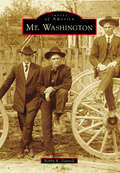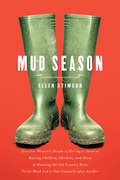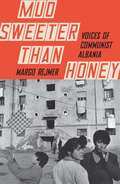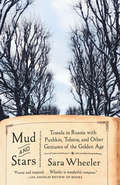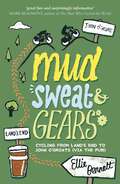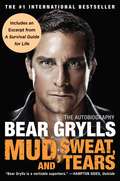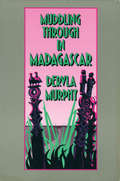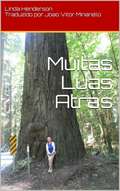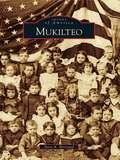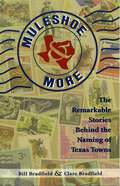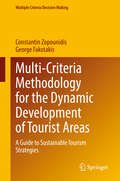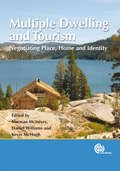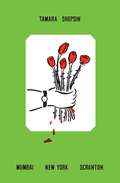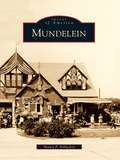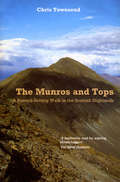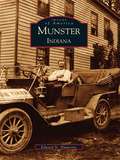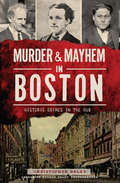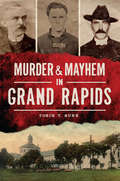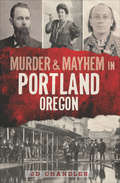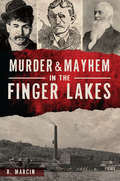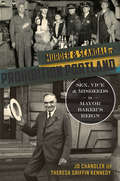- Table View
- List View
Mt. Washington (Images of America)
by Bobby K. DarnellWhen pioneers first ventured off the Wilderness Road in the late 1700s looking for a more direct route to Louisville, they came upon a pleasant area between the Salt River and Floyd's Fork. It provided rich soil for farmland, virgin timber for building, plentiful game, and numerous springs. As roads from Bardstown to Louisville and Shepherdsville to Shelbyville and Taylorsville were forged, the area was nicknamed "The Crossroads." In 1818, the community was named first Mt. Vernon and then Mt. Washington. The town grew tremendously, outgrowing all of its neighboring cities in Bullitt County for decades. As many as five hotels existed in the mid-1800s, and a private school named Mt. Washington Academy, greatly praised as "The Athens of this Place," drew students from miles away.
Mud Season: How One Woman's Dream of Moving to Vermont, Raising Children, Chickens and Sheep, and Running the Old Country Store Pretty Much Led to One Calamity After Another
by Ellen StimsonAfter a getaway in gorgeous rural Vermont--its mountains ablaze in autumnal glory, its Main Streets quaint and welcoming--Ellen Stimson and her family make up their minds even before they get back to St. Louis: "We're moving to Vermont!" The reality, they quickly learn, is a little muddier than they'd imagined, but, happily, worth all the trouble. In self-deprecating and hilarious fashion, Mud Season chronicles Stimson's transition from city life to rickety Vermont farmhouse. When she decides she wants to own and operate the old-fashioned village store in idyllic Dorset, pop. 2,036, one of the oldest continually operating country stores in the country, she learns the hard way that "improvements" are not always welcomed warmly by folks who like things just fine the way they'd always been. She dreams of patrons streaming in for fresh-made sandwiches and an old-timey candy counter, but she learns they're boycotting the store. Why? "The bread," they tell her, "you moved the bread from where it used to be." Can the citified newcomer turn the tide of mistrust before she ruins the business altogether? Follow the author to her wit's end and back, through her full immersion into rural life--swapping high heels for muck boots; raising chickens and sheep; fighting off skunks, foxes, and bears; and making a few friends and allies in a tiny town steeped in history, local tradition, and that dyed-in-the-wool Vermont "character."
Mud Sweeter than Honey: Voices of Communist Albania
by Margo Rejmer"Albania, enigmatic, mysterious Albania, was always the untold story of the Cold War, the 1989 revolutions and the fall of the Berlin Wall. Mud Sweeter Than Honey goes a very long way indeed towards putting that right." CHARLIE CONNELLY, New European"A moving evocation of the 'everyday terror' systematically perpetrated over 41 years of Albanian communism . . . An illuminating if harrowing insight into life in a totalitarian state." Clarissa de Waal, author of ALBANIA: PORTRAIT OF A COUNTRY IN TRANSITIONAfter breaking ties with Yugoslavia, the USSR and then China, Enver Hoxha believed that Albania could become a self-sufficient bastion of communism. Every day, many of its citizens were thrown into prisons and forced labour camps for daring to think independently, for rebelling against the regime or trying to escape - the consequences of their actions were often tragic and irreversible. Mud Sweeter than Honey gives voice to those who lived in Albania at that time - from poets and teachers to shoe-makers and peasant farmers, and many others whose aspirations were brutally crushed in acts of unimaginable repression - creating a vivid, dynamic and often painful picture of this totalitarian state during the forty years of Hoxha's ruthless dictatorship.Very little emerged from Albania during communist times. With these personal accounts, Rejmer opens a window onto a terrifying period in the country's history. Mud Sweeter than Honey is not only a gripping work of reportage, but also a necessary and unique portrait of a nation.With an Introduction by Tony Barber*Winner of the Polityka Passport Prize**Shortlisted for the Nike Prize*Translated from the Polish by Zosia Krasodomska-Jones and Antonia Lloyd-Jones
Mud and Stars: Travels in Russia with Pushkin, Tolstoy, and Other Geniuses of the Golden Age
by Sara WheelerWith the writers of the Golden Age as her guides—Pushkin, Tolstoy, Gogol, and Turgenev, among others—Sara Wheeler searches for a Russia not in the news, traveling from rinsed northwestern beet fields and the Far Eastern Arctic tundra to the cauldron of nationalities, religions, and languages in the Caucasus. Bypassing major cities as much as possible, she goes instead to the places associated with the country&’s literary masters. With her, we see the fabled Trigorskoye (&“three hills&”) estate that Pushkin frequented during his exile, now preserved in his honor. We look for Dostoevsky along the waters of Lake Ilmen, site of the only house the restless writer ever owned. We pay tribute to the single stone that remains of Tolstoy&’s birthplace. Wheeler weaves these writers&’ lives and works around their historical homes, giving us rich portraits of the many diverse Russias from which these writers spoke. As she travels, Wheeler follows local guides, boards with families in modest homestays, eats roe and pelmeni and cabbage soup, invokes recipes from Mastering the Art of Soviet Cooking, learns the language, and observes the pattern of outcry and silence that characterizes life under Vladimir Putin. Illustrated with both historical images and contemporary snapshots of the people and places that shaped her journey, Mud and Stars gives us timely, witty, and deeply personal insights into Russia, then and now.
Mud, Sweat and Gears: Cycling from Land's End to John O'Groats (Via the Pub)
by Ellie BennettAs Ellie’s fiftieth birthday approaches, her ambitions of a steady income, a successful career and an ascent of Everest seem as far away as ever. So when her best friend Mick suggests a cycle from Land’s End to John o’Groats, she agrees. But as they sample local beer along the way, she wonders if they’ll ever make it to the finish line…
Mud, Sweat and Gears: Cycling from Land's End to John O'Groats (Via the Pub)
by Ellie BennettAs Ellie’s fiftieth birthday approaches, her ambitions of a steady income, a successful career and an ascent of Everest seem as far away as ever. So when her best friend Mick suggests a cycle from Land’s End to John o’Groats, she agrees. But as they sample local beer along the way, she wonders if they’ll ever make it to the finish line…
Mud, Sweat, and Tears: The Autobiography
by Bear Grylls“Bear Grylls is a veritable superhero….The former UK Special Forces paratrooper has braved the world’s harshest environments.” —Hampton Sides, Outside Magazine“Bear Grylls is one tough, crazy dude.” —Washington PostTHE THRILLING #1-BESTSELLING MEMOIR BY THE ADVENTURE LEGEND AND STAR OF NBC'S RUNNING WILD WITH BEAR GRYLLSBear Grylls has always sought the ultimate in adventure. Growing up on a remote island off of Britain's windswept coast, he was taught by his father to sail and climb at an early age. Inevitably, it wasn't long before the young explorer was sneaking out to lead all-night climbing expeditions.As a teenager at Eton College, Bear found his identity and purpose through both mountaineering and martial arts. These passions led him into the foothills of the mighty Himalayas and to a karate grandmaster's remote training camp in Japan, an experience that soon helped him earn a second-degree black belt. Returning home, he embarked upon the notoriously grueling selection course for the British Special Forces to join the elite Special Air Service unit 21 SAS—a journey that would push him to the very limits of physical and mental endurance.Then, disaster. Bear broke his back in three places in a horrific free-fall parachuting accident in Africa. It was touch and go whether he would walk again, according to doctors. However, only eighteen months later, a twenty-three-year-old Bear became one of the youngest climbers to scale Mount Everest, the world's highest summit. But this was just the beginning of his many extraordinary adventures. . . .Known and admired by millions as the star of Man vs. Wild, Bear Grylls has survived where few would dare to go. Now, for the first time, Bear tells the story of his action-packed life. Gripping, moving, and wildly exhilarating, Mud, Sweat, and Tears is a must-read for adrenaline junkies and armchair explorers alike.
Muddling Through in Madagascar
by Dervla MurphyEverything about Madagascar is surprising, as Dervla Murphy and her 14-year-old daughter, Rachel, found to their delight. Despite accidents, misadventures, contrasts and the political instability of the Great Red Island, they returned with a lasting respect for the kindness of its proud people.
Muddling through in Madagascar
by Dervla MurphyA hilarious and perceptive travel journal. “Everything about Madagascar is surprising,” as Dervla Murphy and her 14-year-old daughter, Rachel, found to their delight. Despite accidents, misadventures, contrasts and the political instability of the Great Red Island, they returned with a lasting respect for the kindness of its proud people.
Muddling through in Madagascar
by Dervla MurphyA hilarious and perceptive travel journal. "Everything about Madagascar is surprising," as Dervla Murphy and her 14-year-old daughter, Rachel, found to their delight. Despite accidents, misadventures, contrasts and the political instability of the Great Red Island, they returned with a lasting respect for the kindness of its proud people.
Muitas Luas Atrás: A Magnífica Surpresa de Crimson
by Linda HendersonAs gigantescas sequoias-vermelhas do noroeste da Califórnia tem sido motivo de curiosidade para jovens e adultos por séculos. Este livro conta um pouco da história delas, e como começaram a ser preservadas. É um livro de fotografias, escrito em uma linguagem que crianças conseguem compreender facilmente. Mas, caso você seja um adulto, também pode se surpreender com fatos interessantes que não conhecia sobre a região. Caso você ou alguém que você conheça esteja planejando viajar com a família para lá, este seria um ótimo livro para ler ou dar de presente. Espero que você seja abençoado e faça viagens seguras!
Mujeres del Camino: Emprender el Viaje
by Cristina Silva Turnes Jane V. Blanchard¿Qué es lo que más le gusta de los libros de aventuras: las descripciones del terreno, la cultura, los retos, el desarrollo personal, la interacción con otros aventureros? En Mujeres del Camino: Emprender el Viaje, Jane V. Blanchard combina todos estos elementos en un relato personal y sincero sobre su peregrinación de ochocientos kilómetros en el Camino de Santiago en 2011— cruzando Los Pirineos a pie desde St-Jean-Pied-de-Port en Francia hasta Roncesvalles en España, y luego atravesando el norte de España hacia el oeste, hasta Santiago de Compostela. Durante más de un milenio, fieles cristianos de todo el mundo han hecho esta peregrinación a la Catedral de Santiago, donde se encuentran las reliquias de Santiago Apóstol. Hoy en día, el Camino de Santiago está reconocido como el primer Itinerario Cultural Europeo y es recorrido por gente de todo el mundo. En el año 2011, más de 183 000 peregrinos han completado esta peregrinación; un 44 % eran mujeres. Aunque Mujeres del Camino trata sobre el viaje de Jane en el Camino de Santiago y sus conversaciones con varias mujeres que conoció durante esta peregrinación, este no es un libro solo “para mujeres”. Es un libro sobre el emprendimiento del Camino, el cambio personal y la magia y belleza del Camino Francés, la ruta de peregrinación más popular a Santiago de Compostela. - Descubra por qué gente de todo el mundo hace el Camino. - Aprenda cómo prepararse para el Camino, descubra los ritos diarios y la camaradería presentes entre los peregrinos de hoy en día en las caminatas de larga distancia. - Imagínese la belleza del norte de España a través de las vívidas descripciones que Jane ofrece. - Comprenda por qué tanta gente decide emprender el Camino. “Una reflexión magnífica y conmovedora sobre el Camino”. ~ Adam Nathan “Me sentí como un peregrino más observando los bellos paisajes que Jane describe, sentí e
Mukilteo (Images of America)
by Steve K. BertrandLocated on the waters of Possession Sound, Mukilteo is one of the earliest settlements in Snohomish County. It takes its name, which means "good camping ground," from the Native American people who established a permanent winter village on the spit of land and adjoining salt marsh. Numerous events add to Mukilteo's rich history, including the visit of Capt. George Vancouver in 1792 and Gov. Isaac Stevens's signing of the Point Elliott Treaty in 1855. Founded by Morris Frost and Jacob Fowler in 1860, the city housed the first salmon cannery in Washington and one of the region's earliest breweries. Japanese immigrants became an important part of the community from 1903 to 1930 while working for the Crown Lumber Company. The city's lighthouse, located near the Mukilteo-Clinton ferry dock, has been a well-known fixture since 1906.
Muleshoe and More: The Remarkable Stories Behind the Naming of Texas Towns
by Bill Bradfield Clare BradfieldThis book discloses the humorous and the sometimes controversial, if not curious, circumstances surrounding the naming of more than 700 Texas towns.
Multi-Criteria Methodology for the Dynamic Development of Tourist Areas: A Guide to Sustainable Tourism Strategies (Multiple Criteria Decision Making)
by Constantin Zopounidis George FakotakisThis book explores how multi-criteria analysis (MCA) methodologies can enhance sustainable tourism management in protected areas, with Samaria National Park in Crete as a primary case study. Topics include the global impact of tourism, the role of national parks in conservation, and how nature-based tourism (NBT) supports local economies. Through the Multi-Criteria Satisfaction Analysis (MUSA) method, it examines visitor satisfaction over time, including shifts due to the COVID-19 pandemic, and provides actionable strategies for balancing visitor needs with environmental conservation. Ideal for tourism professionals, environmental policymakers, and researchers in sustainable development, this book bridges theory and practical applications for lasting success in tourism and conservation.
Multiple Dwelling and Tourism: Negotiating Place, Home and Identity
by Norman Mcintyre Daniel R. Williams Kevin E. MchughThe movement of people, goods, capital and information is a central aspect of living in the inter-connected, globalised late-modern world. Although this broader view of mobility is recognized, this book focuses mainly on migration or the movement of people and examines multiple dwelling as a societal response to the major influences of increased mobility and amenity tourism.
Mumbai New York Scranton
by Jason Fulford Tamara ShopsinAn extraordinarily moving memoir from an iconoclastic new talent--an artist, cook, and illustrator whose adventures at home and abroad reveal the importance of living life with your eyes wide open. Best known for her witty illustrations, and as a cook beside her mischievous father in her family's legendary Manhattan restaurant, in Mumbai New York Scranton, Tamara Shopsin offers a brilliantly inventive, spare, and elegant chronicle of a year in her life characterized by impermanence. In a refreshingly original voice alternating between tender and brazen, Shopsin recounts a trip to the Far East with her sidekick husband and the harrowing adventure that unfolds when she comes home. Entire worlds, deep relationships, and indelible experiences are portrayed in Shopsin's deceptively simple and sparse language and drawings. Blending humor, love, suspense--and featuring photographs by Jason Fulford--Mumbai New York Scranton inspires a kaleidoscope of emotions. Shopsin's surprising and affecting tale will keep you on the edge of your seat.
Mundelein
by Shawn P. KillackeyTucked away in the northeastern part of Illinois, just north of Chicago, is the village of Mundelein. Starting out in the mid-1800s as unsettled and unincorporated areas of land, this little village continued to form and grow throughout the years with many settlers, pioneers, and entrepreneurs who wanted to bring their ideas and dreams to this area, from Samuel Insull extending the Chicago-Milwaukee railroad into the community to Card. George Mundelein creating and constructing the St. Mary of the Lake Seminary, which brought half a million people on one day to gather in this unknown village. In turn, the village was named in the cardinal's honor and since its settlement has gone from a population of 500 to over 30,000.
Munros and Tops, The: A Record-Setting Walk in the Scottish Highlands
by Chris TownsendWhen Chris Townsend reached the summit of Ben Hope in Sutherland, he walked his way into the record books. After 118 days in which he had covered more than 1,700 miles and climber over 575,000 feet, he had completed the first single continuous journey of all 277 Munros and 240 Tops in the Scottish Highlands.This is the story of that remarkable walk from the start on Ben More on the Isle of Mull through to the finish, the equivalent of climbing Mount Everest 18 times. For the author, the real enjoyment of the walk was not in counting up the summits or the miles but in spending week after week in the hills and living in the wilds. In THE MUNROS AND TOPS, Chris Townsend recalls the joys of observing the birds and animals, the trees and flowers, the changing shapes of the hills and the play of light on their slopes. He writes about the complexities of route-finding and the challenge of rugged terrain and of coping with often atrocious weather conditions. Illustrated with photographs taken during the walk, this is a stirring account of a unique achievement.
Munster, Indiana
by Edward N. HmurovicMunster, Indiana was referred to as Strathmore on early railroad maps as workers would tirelessly tie "one strath more." When a young man from the Netherlands by the name of Jacob Munster opened Munster's General Store, complete with a small U.S. Postal Station in the back, more residents populated the area, and the "Town of Munster" was founded in 1907.Munster, Indiana is a photographic tour of the places, people, and events that have shaped the Town of Munster from the 1850s onward. Nearly 250 historically significant images capture the town's growth from a simple farming community to the bustling town it is today.
Murder & Mayhem in Boston: Historic Crimes in the Hub (Murder And Mayhem Ser.)
by Christopher DaleyA century of Boston&’s thrill killers, psychos, and fiends—notorious in their day, now nearly forgotten—from the Antebellum era through the 1970s. The Boston Strangler may be the most infamous serial killer in Massachusetts history, but his crimes pale in comparison with the carnage of those profiled in this chilling compendium. Covering a century the city&’s heinous past, journalist Christopher Daley reveals nine of the most sensational cases that once made headlines across the country: Kenneth Harrison, aka &“The Giggler&” whose random victims ranged from children to men to an elderly woman he tossed over the Broadway Bridge, just for fun; upstanding Albert Tirrell, who claimed he was sleepwalking when he slit the throat of his mistress, prostitute Maria Bickford, and set her on fire; Jesse Pomeroy, a natural-born sadist and, at fourteen, the youngest convicted serial killer in the annals of American crime. Here too are the shocking tales of the Bussey Woods murders, the Barrel Butcher, the Boston Skull Cracker, and more. Featuring rare photographs, as well as maps to extant crime scenes, Murder & Mayhem in Boston is a must for true crime aficionados.
Murder & Mayhem in Grand Rapids (Murder & Mayhem)
by Tobin T. BuhkWhile the River City is known for its history of furniture making, it also has a sinister side. Jennie Flood was a widow with a get-rich scheme that involved a shotgun and an insurance application. Reverend Ferris went undercover in his war against the city's purveyors of vice. The police rounded up the usual suspects in an attempt to solve the infamous 1921 bank heist that led to the slaying of two detectives. And the death of a teenager exposed "Aunty" Smith and her dangerous side business conducted in the shadows. Author Tobin T. Buhk delves into the colorful characters of Grand Rapids' past and the heinous crimes they committed.
Murder & Mayhem in Portland, Oregon (Murder And Mayhem Ser.)
by JD ChandlerA shocking true chronicle of some of Portland, Oregon&’s most infamous criminal cases—from its wild roots as a frontier town to post-war 20th century. Here are some of the most horrifying crimes that made headlines and shook Portland, Oregon. The brutal Ardenwald axe murders. The retribution killings by Chinatown tongs. The fiendish acts of the Dark Strangler. In this compelling account, author JD Chandler chronicles the coverups, false confessions, miscarriages of justice, and the investigative twists of Portland&’s sordid past. From the untimely end of the Black Mackintosh Bandit to the convoluted hunt for the Milwaukie Monster, Murder & Mayhem in Portland, Oregon is a true crime account that acknowledges the officers who sought justice and remembers the victims whose lives were claimed by violence—all while providing important historical context.
Murder & Mayhem in the Finger Lakes (Murder & Mayhem)
by R. MarcinThe pristine waters of the Finger Lakes inspire tranquility, but the region has not been spared a history of high-profile murders. George Chapman's execution for killing a hostler in a drunken rage drew one of the largest crowds in Seneca County's history. Charles Sprague was the only person from Yates County to be executed and the last person electrocuted at Auburn Prison after shooting a neighbor in a dispute over potatoes. A plea of insanity did not save James Williams from the electric chair after murdering an elderly man and attempting to rape a teenage girl. In the Feedbag Murder, the body of a missing man was found in a canal, and his friend was acquitted of the murder despite confessing to the crime years later. Author R. Marcin explores the gruesome history of homicide in the Finger Lakes.
Murder & Scandal in Prohibition Portland: Sex, Vice & Misdeeds in Mayor Baker's Reign (True Crime)
by Jd Chandler Theresa Griffin KennedyThe 1917 election of Mayor George Luis Baker ushered a long era of unscrupulous greed into Portland government. While supposedly enforcing prohibition laws, Baker ordered police chief Leon Jenkins to control and profit from the bootlegging market. Baker filled city coffers and his friends' pockets with booze-soaked cash while sensational headlines like the 1929 affair between policeman Bill Breuning and informant Anna Schrader scandalized the city. Maligned in the press, Schrader executed a bitter campaign to recall the mayor. In 1933, a hired gunman murdered special investigator to the governor Frank Aiken a day before he would have filed a report on corruption in the city government. Authors JD Chandler and Theresa Griffin Kennedy unearth the salacious details of Baker's crooked administration in a revelatory account of prohibition in the Rose City.
